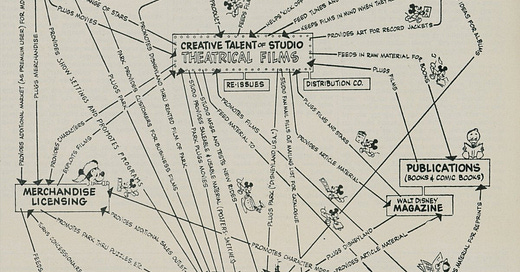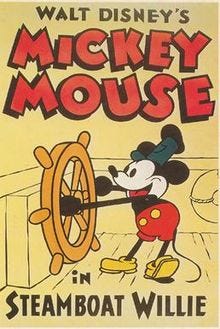Welcome to the MoneyNeverSleeps newsletter! Thanks to the 127 new fans who signed up for the newsletter this week.
If you’re reading this but haven’t subscribed, now’s the time to join!
The boy is back in the booth, ready to tap into truth
Too many lyrics 'bout houses and loot
Too many Walt Disney characters, mouses and goofs
I mean you know I love a challenge, but challenged by who?
- ‘Is There More?’ by Drake
I have spent a large part of lockdown watching Disney+ with the kids. My daughters, in particular, can’t get enough of the animated movies. (I have yet to get them watching Star Wars or any of the Marvel movies….that might take a bit longer!)
At this point, I think it is fair to say we have seen most of the movies on offer now. With one key exception (and one we all see without noticing).
Steamboat Willie, pictured above, was a short animated film directed in 1928 by Walt Disney. It was produced in black-and-white by Walt Disney Studios and was released by Celebrity Productions.
The cartoon is considered the debut of Mickey Mouse, and his girlfriend Minnie, and was the first fully synchronized sound cartoon.
It is one of the most important films in the history of The Walt Disney Company.
But, let’s talk about another very important part of the Disney story, that is also hiding in plain site.
I introduce to you….The Disney Flywheel
What is the Disney Flywheel? The Walt Disney Company is designed so that everything that Disney owns works together and feeds into each other.
Disney creates and acquires worlds and characters for movies and shows. This is its intellectual property (“IP”).
It then builds theme parks based off of the same IP, which entices people to visit those theme parks.
It sells people merchandise based off of that IP when they’re in the parks or in any of the 387 Disney stores globally.
Owning Disney merchandise builds a deeper connection with the wider brand, which makes consumers want to go see the next movie, and the cycle continues.
Just to put some numbers around this particular piece of the flywheel - in 2018, Disney generated $54.7bn in retail sales of licensed merchandise globally.
Because of the power of its Flywheel, Disney is able to create the Holy Grail of business strategy: consumers effectively pay Disney to market to them.
Why Should You Care?
A company’s flywheel explains why it becomes easier to run a business as it continues to operate.
Its a similar concept to ‘compounding interest’ in so far as the investments you make in one area of the business flow through to every other area of the business.
As X increases, it leads to more of Y, which in turn increases Z. As Z increases it flows back to X and the cycle begins again.
This can potentially set off a series of compounding advantages that the company enjoys over time.
A company that understands its own flywheel can identify where the wheel is spinning smoothly, and where a little bit of effort/focus might come in handy.
When you think of a Disney, Amazon, Stripe, etc and other successful businesses out there, I believe that behind every one is a flywheel that is well understood by the team.
Look at your business.
Do you have a ‘flywheel’ or do you see the potential for one?
Where is the wheel spinning smoothly and where does it need some extra ‘grease’?
Focus on that, and watch it compound.
Remember, the Mouse knows best!
Tell me why I’m wrong…
- Eoin
Left Field
How do I describe ‘Left Field’? It’s a place to put the content (newsletters/articles, etc) that we have amassed over recent weeks or previous years that really make us think or change our thinking on a particular topic. All the content will offer an alternative view of some topic in financial services, technology or sport (or a combination of all three!)
Why big companies squander brilliant ideas
Another favourite author of mine, Tim Harford, details some of the great inventions of their time that were conceived inside large companies but only turned into great products in the hands of startups.
Anyway, I won’t give away too much. Enjoy the article and feel free to get in touch to discuss more!
- Eoin
Can’t Sleep?
MoneyNeverSleeps podcast episode from this week:
Episode 111: Move the Crowd | Chris Burge and Spark Crowdfunding
Chris Burge from Spark Crowdfunding joins the show to talk about two-sided marketplaces, the differences between crowdfunding for B2C and B2B companies, his own transition from the life of an energy consultant to that of a crowdfunding platform operator….and the long-term benefits of stag weekends!
Podcast Recommendation: Highly recommend checking out ‘Here’s The Thing’ where Alec Baldwin brings listeners into the lives of artists, policy makers and performers.
Book Recommendation: I highly recommend the book, ‘The Undercover Economist’, where Tim Harford a fresh explanation of the fundamental principles of the modern economy, illuminated by examples from the streets of London to the booming skyscrapers of Shanghai to the sleepy canals of Bruges.
This newsletter has been written by Eoin Fitzgerald and Pete Townsend
Want more MoneyNeverSleeps?
Check out the MoneyNeverSleeps Podcast on Apple Podcasts, Spotify and all major podcast platforms.






